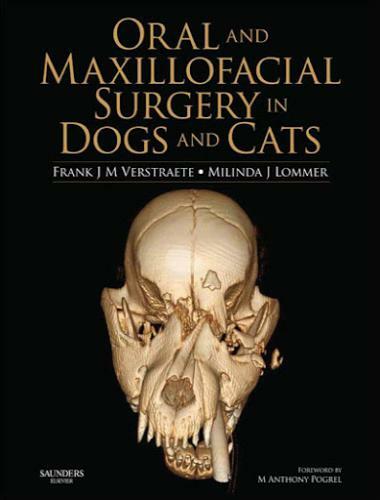Oral and Maxillofacial Surgery in Dogs and Cats
by Frank J M Verstraete in March, 2012
Oral and maxillofacial surgery is an exciting and rewarding field, offering practitioners numerous opportunities to
 improve their patients’ quality of life. Because oral diseases and maxillofacial lesions are often painful and debilitating, treating these conditions can have a huge impact on an animal’s well-being. Unfortunately, although oral diseases are prevalent among companion animals, and veterinarians are expected to diagnose and treat them, the anatomy, physiology, and pathology of the oral cavity are discussed only cursorily in veterinary school. This textbook aims to provide students, general practitioners, residents and specialists with a comprehensive survey of oral and maxillofacial surgery. Each chapter includes the ‘why’ as well as the ‘how’, and the procedures described range from non-surgical, single-rooted tooth extraction to major resection of maxillary and mandibular tumors. It is important to note that the text is not intended to be a ‘step-by-step’ guide to performing these procedures, and that practitioners interested in learning a particular procedure described in the text should pursue additional training with a board-certified specialist before attempting an unfamiliar surgical procedure on a patient.
improve their patients’ quality of life. Because oral diseases and maxillofacial lesions are often painful and debilitating, treating these conditions can have a huge impact on an animal’s well-being. Unfortunately, although oral diseases are prevalent among companion animals, and veterinarians are expected to diagnose and treat them, the anatomy, physiology, and pathology of the oral cavity are discussed only cursorily in veterinary school. This textbook aims to provide students, general practitioners, residents and specialists with a comprehensive survey of oral and maxillofacial surgery. Each chapter includes the ‘why’ as well as the ‘how’, and the procedures described range from non-surgical, single-rooted tooth extraction to major resection of maxillary and mandibular tumors. It is important to note that the text is not intended to be a ‘step-by-step’ guide to performing these procedures, and that practitioners interested in learning a particular procedure described in the text should pursue additional training with a board-certified specialist before attempting an unfamiliar surgical procedure on a patient.
We also wish to point out that procedures which we feel are ethically questionable (performed for the purpose of pleasing the client or demonstrating the technical prowess of the operator rather than to improve the patient’s quality of life) are not included in this book. We specifically refer to orthognathic surgery and dental implants. Orthognathic surgery is complicated, puts the animal at risk of serious complications, and is rarely justifiable. While we aim to restore a comfortable and functional occlusion to our patients, the goal of correcting a malocclusion through orthognathic surgery is misguided, particularly since malocclusions causing discomfort can typically be treated by orthodontic means or by selective extractions. Regarding the replacement of missing teeth, although dogs have been used extensively in dental implant research, it is very difficult to provide ethical justification for implant surgery in client-owned animals given how well dogs and cats function with missing teeth.
This textbook was compiled with the contribution of experts in human oral pathology and maxillofacial surgery as well as board-certified veterinary surgeons and dentists. The information contained is based on reviews of relevant literature and the clinical expertise of the authors. We have attempted to make the text comprehensive, authoritative, and easy to read. Every effort has been made to ensure that the nomenclature used in this textbook is correct and in agreement with Nomina Anatomica Veterinaria. Intentional repetition of some material is present throughout several chapters to allow for complete presentation of the material in the individual chapters, and to reinforce basic surgical principles relative to the specific procedures described.
| PDF Size: 170 MB | Book Download Free |
Password: pdflibrary.net
Password: pdflibrary.net
